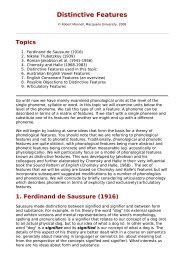The Syllable and the Foot : Summary - Speech Resource Pages
The Syllable and the Foot : Summary - Speech Resource Pages
The Syllable and the Foot : Summary - Speech Resource Pages
Create successful ePaper yourself
Turn your PDF publications into a flip-book with our unique Google optimized e-Paper software.
<strong>The</strong> foot is analogous to <strong>the</strong> bar in music <strong>and</strong> spoken utterances<br />
consist of a succession of feet in <strong>the</strong> same way that music consists<br />
of a succession of bars. <strong>The</strong> first syllable of each foot is always<br />
strong.<br />
Click here to see an example of <strong>the</strong> complex relationship between<br />
word boundaries, foot boundaries <strong>and</strong> prosodic phrase boundaries.<br />
Quantity-sensitive Feet<br />
In some languages, <strong>the</strong> choice of primary stress is related to <strong>the</strong><br />
number <strong>and</strong> type of segments in <strong>the</strong> syllable rhyme <strong>and</strong> this is<br />
called quantity-sensitivity. <strong>Syllable</strong>s are considered to be ei<strong>the</strong>r<br />
heavy or light depending on <strong>the</strong> segmental constituents of <strong>the</strong><br />
rhyme.<br />
Heavy <strong>and</strong> Light syllables<br />
A light syllable is defined as any (C)V syllable where (C) is zero or<br />
more consonants, <strong>and</strong> where <strong>the</strong> V is one of /ɪ e æ ɐ ʊ ɔ/ (as in<br />
'hid', 'head', 'had', 'hud', 'hood', 'hod') or /ə/. (<strong>The</strong> simplest way to<br />
remember <strong>the</strong>se vowels is to ask yourself whe<strong>the</strong>r <strong>the</strong>re are any<br />
open monosyllables with such vowels in English - <strong>the</strong>y are also<br />
phonetically quite short). A light syllable also includes (C)VC<br />
syllables in word-final position - so <strong>the</strong> last syllable of 'imagine' is<br />
light.<br />
All o<strong>the</strong>r types of syllables - that is (C)VC syllables which are not<br />
word-final, (C)VCC syllables, (C)V: syllables where V: is any o<strong>the</strong>r<br />
vowel or diphthong not listed above, or (C)V:C syllables all count as<br />
heavy.<br />
What kinds of syllables are metrically<br />
weak?<br />
In order to be able to work out <strong>the</strong> prosodic tree structure for any<br />
word, it's obviously important to be able to identify which syllables<br />
are strong <strong>and</strong> weak. This is fact quite easy because, apart from all<br />
weak syllables necessarily being Light (see above), <strong>the</strong> very large<br />
majority of weak syllables have a /ə/ vowel, or a vowel that can<br />
reduce to schwa (for example, <strong>the</strong> second syllable of 'minimum'<br />
which can be ei<strong>the</strong>r /ɪ/ or /ə/). <strong>The</strong>re are a few o<strong>the</strong>r kinds of weak<br />
syllables that don't have a /ə/ as <strong>the</strong>ir vowel. <strong>The</strong>se are listed<br />
below:
















